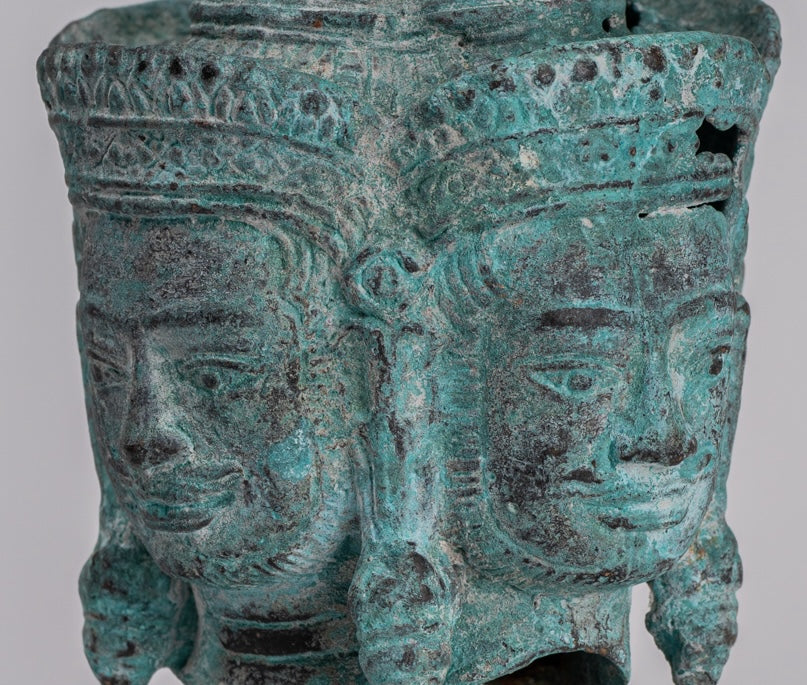
Unveiling the Divine Form: Exploring the Difference Between 4-Arm and 8-Arm Brahma
Introduction
In Hindu mythology, Lord Brahma, the creator deity, is often depicted with multiple arms symbolizing his cosmic power and divine attributes. However, Brahma's depictions vary, with some representations showing him with four arms and others with eight.
In this comprehensive blog post, we delve into the significance of these different manifestations of Brahma, exploring their symbolic meanings, mythological origins, and spiritual teachings.
1. The Iconography of Brahma
Before delving into the distinction between the four-arm and eight-arm forms of Brahma, it's essential to understand the general iconography of this revered deity.
-
Four Arms: In his four-arm form, Brahma typically holds various symbolic attributes, sometimes including a rosary (akshamala) symbolizing the passage of time, a water pot (kalasha or kamandalu) representing creation, a Vedas script, and a lotus flower signifying purity and transcendence.
-
Eight Arms: The eight-arm depiction of Brahma expands upon the symbolism of his four-arm form, with additional attributes such as a bow and arrow, a sword, a goad (ankusha), a noose (pasha), and a staff (danda). These weapons represent Brahma's role as a protector and upholder of cosmic order.
2. Mythological Origins and Symbolism
The differentiation between the four-arm and eight-arm forms of Brahma finds its roots in Hindu mythology and symbolism.
-
Four-Arm Brahma: The four-arm depiction of Brahma is perhaps the most common and represents the essential aspects of creation, preservation, and transcendence. His four arms symbolize the four directions, the four Vedas, and the four stages of human life (ashramas).
-
Eight-Arm Brahma: The eight-arm form of Brahma is less common but holds profound symbolic significance. Each of Brahma's additional arms represents a specific attribute or cosmic function, such as protection, governance, and cosmic balance. The weapons wielded by Brahma in his eight-arm form symbolize his ability to overcome obstacles and maintain cosmic order.
3. Spiritual Teachings and Philosophical Significance
The depiction of Brahma with multiple arms serves as a visual metaphor for the multifaceted nature of divinity and the cosmic forces at play within the universe.
-
Unity in Diversity: Whether depicted with four arms or eight, Brahma symbolizes the unity underlying diversity—the interconnectedness of all existence and the harmonious balance of opposing forces within the cosmos.
-
Dynamic Creation: Brahma's multiple arms convey the dynamic and multifaceted nature of creation, with each arm representing a different aspect of the creative process—whether it be the unfolding of time, the expression of knowledge, or the wielding of cosmic forces.
4. Devotional Practices and Iconography
In Hindu worship and devotional practices, both the four-arm and eight-arm forms of Brahma hold significance, with devotees invoking Brahma's blessings for creativity, wisdom, and divine inspiration.
- Temples and Shrines: Temples dedicated to Brahma often feature images or sculptures depicting him in both his four-arm and eight-arm forms. Devotees visit these sacred sites to offer prayers and seek blessings for auspicious beginnings, creative endeavors, and spiritual growth.
Conclusion
In the divine forms of Brahma, we encounter a rich tapestry of symbolism, mythological lore, and spiritual teachings that illuminate the multifaceted nature of creation and the cosmic forces at play within the universe.
Whether depicted with four arms or eight, Brahma serves as a potent symbol of creative power, cosmic governance, and spiritual transcendence—a reminder of the eternal dance of creation, preservation, and transformation that animates the cosmos.
As we contemplate Brahma's divine forms, may we awaken to the inherent divinity within ourselves and recognize the sacred interplay of forces that shape our lives and the world around us.


